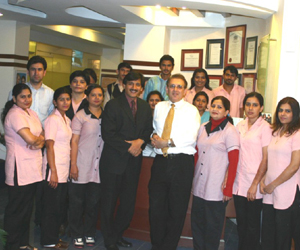
Humayun Mohmand grew up in different cities in Pakistan.Education was highly stressed during his childhood, as his father was an “educationist” an expert in the theories and administration of education in the Army, and his family was transferred from one place to another. Rather than pursue an engineering career in his father’s school, Humayun decided to follow the path of medicine. His early education was in one of the most esteemed institutions, “Cadet College Hasanabdal,”and he completed his medical studies at the Ayub Medical College of Abbottabad.
Humayun quickly recognized his interest in surgery, specifi cally plastic surgery, and he earned a fellowship from the Royal College of Surgeons in Edinburgh. Here he developed his skills and experience in General Surgery, but later trained in several hospitals in the United Kingdom where he acquired experience and a love for plastic surgery. Humayun returned to Pakistan to practice. Initially his practice focused on reconstructive surgery, but his interest
gradually evolved into cosmetics. By 2000 his practice was primarily cosmetic surgery, specializing in rhinoplasty and liposuction. He has always had an eye for cosmetics and beauty; “My results are seen by everyone and recognized by none” is Humayun’s motto and aim. In 2002 Humayun attended the Orlando Live Surgery Workshop (OLSW) for the fi rst time. Here he was inspired by the lectures on hairline design, especially those by Ron Shapiro. He was impressed with the natural results shown at the workshop. Over the next few years, his practice evolved into 70% hair restoration, and the rest cosmetic surgery. Humayun has regularly attended both the ISHRS annual meetings, the ESHRS, and the OLSW, improving his skills in hair restoration.In 2005, at the ISHRS Annual Scientifi c Meeting in Sydney,he delivered a lecture entitled, “Hair curvature: an important factor in natural looking hairline.” His poster on creating temporal peaks and fronto-temporal angles won the best tip award at the 2006 Annual Scientifi c Meeting in San Diego. To further the art of hair restoration in Pakistan, Humayun established the Hair Transplant Institute Islamabad. He has 17 highly trained technicians and his clinic is equipped to perform 4 surgeries simultaneously. He offers a one-on-one,full hands-on course, including instruction in all the steps of hair restoration surgery and FUE techniques. Physicians from India, the United Kingdom, and Pakistan have attended this course. Humayun is married and has three children, a son and two daughters. His son has chosen to become a doctor and aspires to walk in Humayun’s footsteps. His elder daughter has developed a keen interest in tennis, and Humayun hopes her skills will progress such that she can compete internationally. His youngest daughter is 8. Humayun has two favorite pasttimes: movies and golf. His current handicap is18, but he aspires to be a 10, and his best round was 9 over par. His most memorable experience was a hole in one on a par four: “It was a dog leg, I went for the green over the trees, and it went into the cup. That was actually an albatross as well. It was the fi rst and last time I landed on that green in one go.” Humayun does a lot of pro bono surgeries, especially for females. He recalls one such patient who believed her hair loss waspreventing her from getting married. Apparently in certain poor villages, hair loss is a taboo, and no one was interested in marrying her. Following two procedures,her hair loss was restored; she married, and attributes her marriage to these surgeries and to Dr. Humayun. The other case is that of an indigent patient who would never remove his baseball cap. After two sessions, he now lives a normal life without a cap. After his medical career, Humayun aspires to go into politics. His aim is to purge Pakistan from corruption and dishonesty, and work for the betterment of his people.